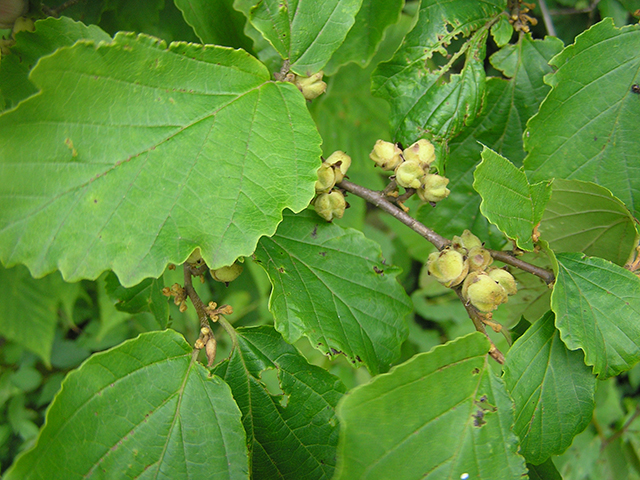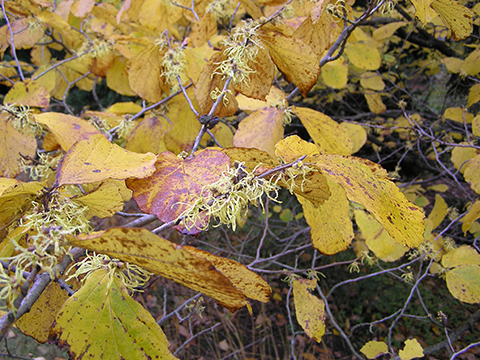 |
| Home | Ordering By Mail | Purchase Manual: Using Native Plants in Urban Landscapes |
|
|||||
Species Name: Hamamelis virginiana
Common Name: Witch Hazel
Zone: 3 to 8
Distribution: Quebec and Nova Scotia south to Florida south to Florida and Texas
Seed collection: The flowers of witch hazel bloom in the fall typically in mid to late October before the leaves drop.
The ovules are not pollinated until the spring when the flowers are wind pollinated. The seeds develop over the summer
inside a capsule that holds 1 to 2 elongated black seeds. The seed matures in late August and is dispersed form September to October
at the same time the plant is in flower. The seed is dispersed by mechanical means.
As the capsule dries it begins to split which creates tension on the seed. As the tension builds the force is suddenly released
propelling the seed from the capsule under great force. The seed is projected many feet from the plant.
This is the primary means of seed dispersal.
Witch hazel seldom produces an abundance of fruits in the wild. Large seed crops are produced about once every 4 to 5 years.
Open grown plants reliably produce more seed than plants growing in shade. Although the plant is monoecious, cross pollination
between 2 or more plants is necessary for good seed set. Mice, chipmunks and squirrels are the primary consumers of the small hard seeds.
To collect seed, harvest the capsules in early fall as they begin to open. Collect all of the capsules at once
and place them in a sealed container or paper bag. Collecting the capsules when they first mature in late August will likely increase germination rates.
Seed handling: Place the capsules in a dry and warm environment to continue drying to release the seeds.
You can audibly hear the seeds being catapulted from the capsules. After separating the seed from their capsules
the seed should be immediately cold moist stratified. The seeds have a hard seed coat and seed may have an undeveloped embryo that delays germination.
A hot water soak in hot but not boiling water prior to stratification may function to break down the seed coat and increase germination.
Germination requirements: A small percentage of stratified seed may germinate the first spring, but most of the seed will germinate
the second spring or even later. There is no seed handling method that has been proven to deliver consistent uniform germination.
Planting immediately after separation from the capsules is a common nursery practice and often leads to higher germination rates.
Monitor the seed for germination in storage and plant when there are clear signs of germination. Stored or stratified seed can be planted
in the spring or the following fall. Germinating seeds can be individually removed and planted leaving the rest of the seed to continue stratifying.
Seed can be planted in prepared seedbeds or planted in the wild. Young seedlings require up to 50% shade during the first year and as well as good weed control.
Ecology: Witch hazel is a large multi-stemmed shrub usually found in the understory of deciduous forests. It can grow to be 20 ft high and wide
sometimes reaching small tree proportions. It can be found growing in both dry upland woods and in rich moist soils. It is long-lived and tolerant of a range of soils
and moisture conditions except saturated soils. It is often found growing in clusters because of the limited dispersal range of its seed.
Deer will browse the young shoots and seedlings but seldom bother more mature plants. Mature plants suckers moderately from the rootstock.
It is a desirable species for establishing in the understory. It also makes a lovely specimen shrub in the home garden especially in shady locations.

Witch hazel capsules ready for collecting in early June

Witch hazel at flowering time and leaf turn in October
this page posted February 25, 2015